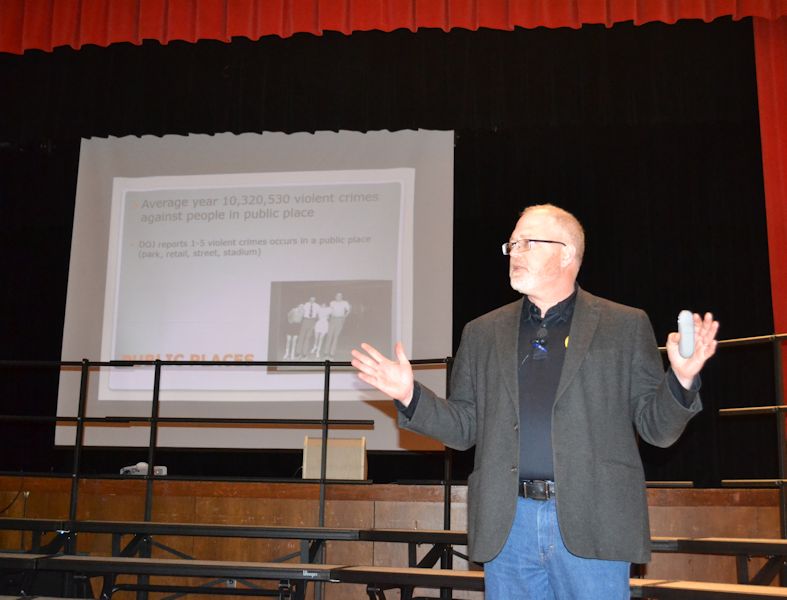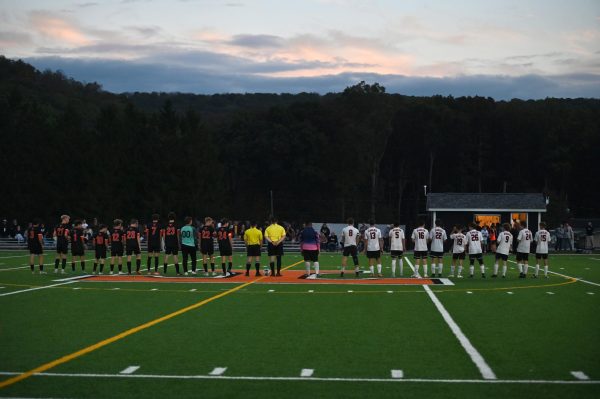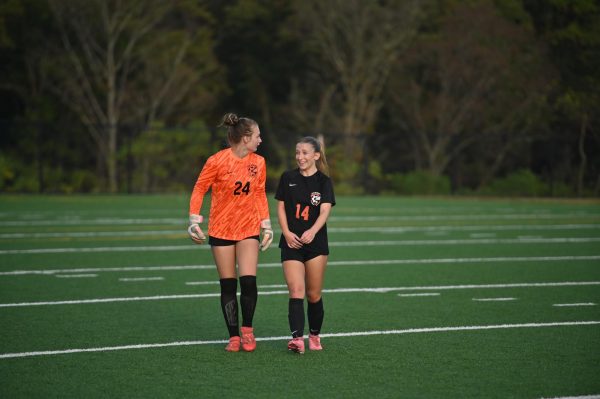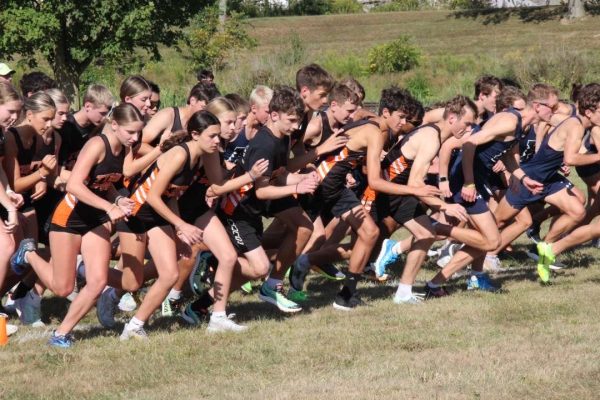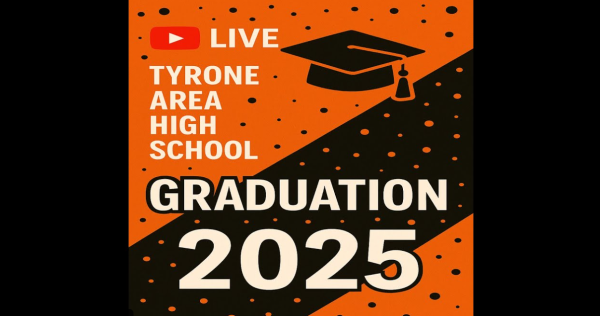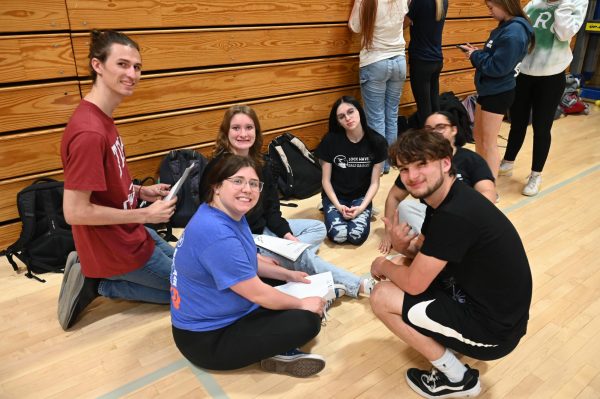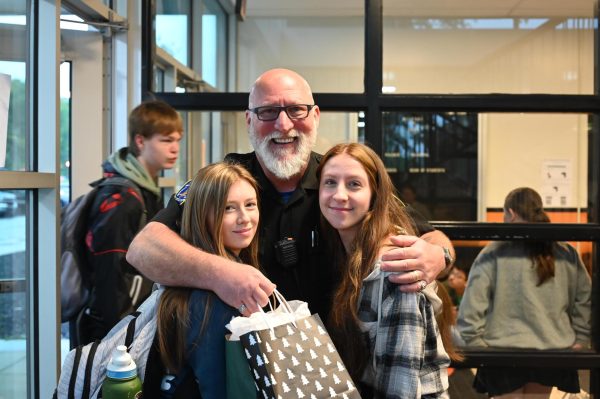Escape, Enhance, Engage: Students and staff learn strategies for handling school violence
Mr. John Baker giving a presentation to TAHS students
April 20, 1999 was just another day in the suburban town of Littleton, Colorado. Columbine High School was preparing for the first lunch shift of the day. Then, the unthinkable happened. Two students opened fire on students at the school. After shooting multiple students in the cafeteria, they moved to the library, where they shot several students hiding under desks. The perpetrators killed 12 students and one teacher before committing suicide.
On Friday, March 6, teachers and staff at Tyrone Area School District heard an unsettling sound: gun shots in the halls of Tyrone High School. Fortunately these gun shots were not as a result of a tragic event like Columbine, but were blanks shot during a training exercise to educate staff on what to do if a violent act should occur.
Mr. John Baker, a US Army veteran, law enforcement officer and security expert for the past 27 years, spoke to the Tyrone students and staff about what to do in a shooting situation, and the fatal mistake that the students in the library of Columbine made that day.
Baker said that the students who were murdered in the library at Columbine were a mere few feet from a door to escape, but instead did what they were all taught to do: go into lockdown mode and hide.
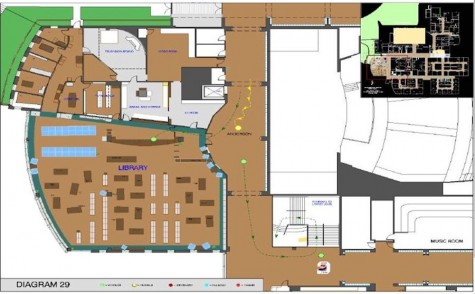
After examining Columbine and other similar events, experts have concluded that there is no one correct way to respond to an event like this. Baker also spoke of the Virginia Tech shooting, where the only students to survive were those who escaped out a classroom window.
Baker told students the importance of “situational awareness”
“Knowing what is going on around you is imperative,” said Baker.
When possible, the first and best option is escape. Had the students at Columbine had better situational awareness, they might have easily escaped to safety and avoided tragedy.
According to Baker, if escape is not possible then the next option is to enhance your defensive position. Barricade doors and reinforce locks if possible.
Finally, as a last resort, Baker encourages people to engage the perpetrator in order to disengage and run. He told staff and students to throw things at the perpetrator; staplers, books, or sweatshirts, really anything that you can throw at someone to disrupt what they are doing, and then run.
“The number one thing I want people to take away from it, I think, is the feeling of being empowered and realizing they can do things to help them survive some really bad situations, while at the same time not being afraid of the ‘what if.’ Knowledge truly is power,” said Baker.
Superintendent Cathy Harlow said that multiple TASD administrators worked together to make this training a reality.

Mr. John Baker
“Several TASD administrators attended violent intruder training during the summer of 2014. Based on their experience, we felt the training would be very beneficial for our entire staff,” said Harlow.
Multiple teachers felt that the training was very helpful and changed the way that they would deal with an intruder situation.
“One of the key elements that we learned was the time factor on how long the situation usually would last,” said English teacher, Mr. David Rutter. “That allows us to have that strong game plan and strategy in order to ensure everyone’s safety.”
The teachers were put into a hands-on simulation of what it would be like to be in an actual school shooting situation. Baker says that the purpose of the simulation is to help the teachers.
“When time permits I love to do some practical scenarios. Again, I don’t think you need to scare people and gross them out with fake blood and all kinds of props. This isn’t a Texas Chain Saw Massacre rehearsal. But, if you teach solid strategies and place people under a little stress by possibly being shot by an air soft gun it’s amazing how they can learn.”
After the training that the teachers participated in on March 6, the high school students were brought in for an assembly that again was headed by Baker. During the presentation Baker asked the students where they thought Pennsylvania would rank for number of school shootings in high schools and colleges combined. Shouts of “top 25” or “top 10” were heard. Baker revealed that Pennsylvania ranks third behind California and Texas.
“It kind of scared me to think that Pennsylvania was third,” said 10th grade student Haley Wagner. “It made me think about how a school shooting could happen anywhere.”
Baker is very confident in his trainings and the success that comes from them. “I do feel this type of training is very successful. Of course the true measure is not what do I think, it’s what did the participants think.”
Tyrone teacher Mr. Cummins McNitt felt the training was very helpful. “I feel safer today having been through the training, however, if someone wants to inflict harm on others it’s pretty difficult to defend against. Should we ever be faced with this sort of situation, I believe this training will help us keep the harm to a minimum – at least that is what we pray for.”
Cathy Harlow agreed with McNitt. “Based on the feedback from staff, the training was a success. It provided staff with information and strategies to employ in the event of a violent intruder. It also provided them the opportunity to simulate various scenarios and practice the skills learned.”

Hey everyone! My name is Paige and I am a sophomore this year at TAHS. This is my second year in Eagle Eye and I am back because I love to provide...

Mr. Todd Cammarata, or "TCamm" as he is known to the Eagle Eye Staff, has been advising the Eagle Eye since 2013. He also advises the Eagle Yearbook...



